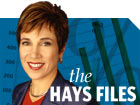
NEW YORK (CNN/Money) -
Double dip recession - it's a phrase we're tossing around so much lately that I assume everyone knows what it means. Until someone says, what is that?
Simply put, it depicts an economy that looks like it's starting to come out of recession, but the recovery never gains enough steam to get on truly solid ground, and the economy "double dips." Given what we saw in the July employment report, more and more economists are saying the odds of that happening are growing.
The economy only managed to create a net 6,000 new jobs last month. June's figure was doubled to show a revised gain of 66,000, and May's figure was downshifted a bit to 22,000. So, for the past three months, the economy has only been able to create a net 94,000 jobs. When the economy is really growing, twice that number of jobs are creaetd in a SINGLE month - easily.
It's true that unemployment was unchanged in July at 5.9 percent. But the rule of thumb is that the economy must produce about 150,000 new jobs each month to bring that jobless rate down. And that ain't happening yet, not by a long shot.
| |
 Econ news
Econ news
| |
| | |
| | |
|
Another worrisome sign: the average workweek was cut to 34 hours, a drop of 0.6 percent. That's the steepest cut since October of last year. Overtime and manufacturing hours also were reduced. Economists say this looks more like firms growing more cautious, perhaps because orders just aren't coming in as strong as they had been.
Temp workers fell by 35,000 in July after growing a total of 145,000 from February to June. Adding temps is what firms do when they see demand picking up or at least hope it will. So that was a good signal when temps were rising. And it's discouraging to see those numbers drop again.
Goldman Sach's splashy call for the Fed to cut rates a cumulative 75 basis points in the fourth quarter sure got the bond market's attention. But I'm hearing the rally there is being driven more by shrinking risk tolerance levels than it is on the possibility of Fed rate cuts.
And, of course, the continued weakness in stocks is one of the primary reasons people fear a double dip recession. With so much wealth destroyed, how can the consumer's psyche possibly remain intact enough to keep spending going?
This leads me to a contrary point: auto sales. They were strong in July. Yes, the auto giants offered incentive financing and that might not be so great for their profits. But it's hard to believe the consumer is shellshocked when car sales are running north of a 17 million unit annual rate.
Another big plus for the economy is that there is a ton of monetary (Fed rate cuts from last year) and fiscal (tax cuts and government spending) stimulus sloshing around. Optimists say all this has yet to fully work through the system and that it will keep the recovery moving ahead.
Let's not forget the mortgage refinancing boom that's underway, either. That puts money in people's pockets. And with the bond market rallying it's possible that already rock-bottom mortgage rates will fall again. At the same time, home prices have risen at a steady clip, creating a wealth effect for many Americans that should help offset the depression caused by stock market losses.
Personal income is still growing. And money supply growth by many measures is healthy. Be patient, say the optimists, and soon you'll see the economy achieve lift off. They argue rate cuts are not only unnecessary but that such a move by the Fed would send a signal of undue worry to already nervous investors.
Still, if the economy is not in a temporary soft spot, if it's sliding anew, then most economists agree with Goldman that rate cuts are inevitable. And the hope is that if they do turn out to be needed they'll come quickly enough to turn the economic tide.

|

